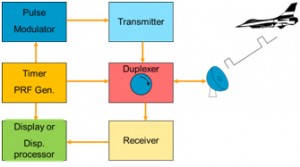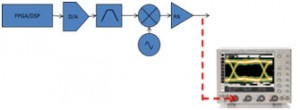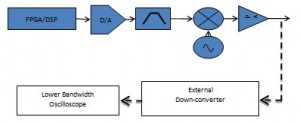Testing wideband RADARs with complex signal types poses potential challenges due to continually increasing modulation and analysis bandwidths. This paper will present how wide bandwidth RADAR complex signals can be created and analyzed with high precision using the modern test systems.
RADARs stands for “RAdio Detection And Ranging” which enable a certain class of objects, termed as “Targets” to be “seen”; which are, detected and located; at distances far beyond those at which they could not be distinguished by the unaided eye. Given the broad range of applications, a variety of radar types and technologies have emerged to meet unique needs viz. CW, Simple Pulse, Pulse Compression, Mono-pulse, Phased Array, Synthetic Aperture, 3D, MIMO, etc. With the modernization of Electronic Warfare (EW) systems modern RADARs are becoming more intelligent and smart to adapt to work in the presence of modern Electronic Counter Measures (ECM) systems, like jammers. Sophisticated phased-array radars may have thousands of transmit/receive (T/R) modules operating in tandem and may use a variety of sophisticated techniques to improve performance: side-lobe nulling, staggered pulse repetition interval (PRI), frequency agility, real-time waveform optimization, wideband chirps, and target recognition capability. Multiple-Input and Multiple-Output (MIMO) radar has generated interest due to its capability of improved target detection and target discrimination potential. Testing such wideband RADARs with complex signal types poses potential challenges due to continually increasing modulation and analysis bandwidths. This paper will present how wide bandwidth RADAR complex signals can be created and analyzed with high precision using the modern test systems.
Introduction
The Principle of RADAR is its ability to gather information about an unknown object primarily called as Target. This information is targets’ presence, distance, direction, type, location and speed. This is normally achieved by processing reflected Radio Frequency (RF) signals from the targets. These types of RADARs are commonly known as primary RADARs. In other cases RADARs transmit a radio frequency (RF) and its reflation form the target is processed. These types of RADARs are known as secondary RADARs. For the rest of the paper we will concentrate on secondary RADAR type.
There are categorized in various ways based upon their applications and one way is to group them based upon their performance
- Military (A/D) –Aircraft (airborne), Ships, ground-based. These radars are used for identifying targets, moving or stationary.
- Commercial–Police (speed detection), weather, automatic door opener, automobiles (backup aides, collision avoidance).
As compared to commercial RADARs, military radars possess higher design and manufacturing challenges as they require very high performance which may include:
→ Higher frequency
- For ground mapping
- Detection of smaller targets
- Provides flexibility in coding
- Better encryption
- Specific RADAR foot-printing
- Better range resolution
- For Longer range
- To detect closer targets
- Cleaner Signal
- Lesser Distortion
- Detection of slow moving targets
- To better track targets.
Figure-1: Simplified RADAR Block diagram and operation
Figure-1 shows a very simplified block diagram of RADAR system. A portion of the transmitted energy is intercepted by the target and reradiated in all directions. This energy that is reradiated back to the radar is of prime interest to the radar. The receiving antenna of the RADAR system collects the returned energy and delivers it to the receiver. The receiver process this received energy to:
- Detect the target
- Extract its location and relative velocity
Also, direction, or angular position, of the target may be determined from the direction of arrival of the returned signal, assuming a narrow antenna beam. If there is relative motion existing between the target and radar, the shift in carrier frequency of the reflected wave which is also called as Doppler’s Effect is a measure of relative radial velocity of the target and can be used to distinguish moving targets from stationary objects.
 Figure-2: Simplified block diagram of pulsed RADAR
Figure-2: Simplified block diagram of pulsed RADAR
Next, let’s take a look at a simplified block diagram of a pulsed radar system as shown in Figure-2. Actual block diagrams could be much more complicated, but this figure shows all of the essential blocks of the radar system. This diagram shows the master timer or PRF generator as the central block of the system. The PRF generator will time synchronize all components of the radar system. This is shown with the connections to the pulse modulator, duplexer or transmit receive switch, and the display processor.
A typical pulsed radars use relatively low duty cycle of the order of 0.1% to 10%, where duty cycle is the ratio of pulse duration divided by period. Refer to Figure-3![]()
Radar range resolution is determined by the pulse width for e.g. a 1μs pulse has a length in space of 150 m and therefore can’t resolver distance less than 150m. The range beyond which targets appear as a second-time-around echo is the maximum unambiguous range.![]() Therefore, long-range radars use very long pulse repetition times.
Therefore, long-range radars use very long pulse repetition times.
For modern RADAR systems the modulation bandwidth requirements are constantly increasing in order to provide longer range and range better resolution. RADAR designers are using modulation bandwidths up to 2 GHz which is planned to be even higher for future developmental needs.
Excellent signal fidelity becomes an important factor so that distortions can to be minimized in order to achieve signals with complex modulation schemes above the noise floor. Traditional signal generators offer excellent signal fidelity, but they usually offer modulation bandwidths of only about 200 MHz. With external arbitrary waveform generators, much wider modulations bandwidth is achievable, but normally at the expense of signal performance.
The basic question as a designer which arises: Why Simulate the Radar Signal?
Traditionally, the RADAR receivers were tested using the actual RADAR which means…Turning on the actual radar.
During the developmental process of the RADAR as a designer he cannot test his receiver until very late in the development process which means until his transmitter design is finished and it is ready for use. Further these tests can be very expensive if a full fly-by test is conducted. (Typical test of a full fly by test can be more than INR 10Cr).
Hence the best and most economical solution is to simulate and generate RADAR signals from commercial off the shelf (COTS) test equipment. This method further provides benefits like:
- Test components, subsystems and full systems much earlier in the design process.
- Much lower coast of testing.
How do we generate this real-time high bandwidth signals with excellent signal fidelity? The key to generate wideband RADAR waveforms is the Agilent M8190A arbitrary waveform generator. M8190A is based on Advanced TCA Extensions for Instrumentation and Test (AXIe) interface platform. This module offers a Digital to Analog Converter (SAC) resolution of 14 bits up to 8 GS/s and 12 bits up to 12 GS/s. This is the basis for excellent signal performance. A 2GSa of waveform memory per channel allow you to build long, realistic scenarios for RADAR simulations. The output path has a 3dB bandwidth of about 5 GHz. This allows you to use the AWG both as I/Q baseband generator or as an IF generator. There are three software selectable output paths available: direct DAC, DC, and AC. Each path is optimized for various applications.
M8190A platform can help uses reduce test costs through realistic signal scenarios that minimize the
need for high-cost flight testing and flexibility to simulate signal scenario with best signal quality in the desired frequency range for long playtimes. e units be connected for >2 channel synchronous generation?
Further, to create mutiple emmitter scenario, several units can be synchronized via trigger and marker. The 2 channels in one instrument can run synchronized wit heach other. The two channels of a module have less than ± 20 ps skew. The delay of each channel is adjustable in 50 fs steps in a range of 0 to 30 ps. In addition 2 instruments can be synchronized.
The following example shows a 10GHz Linear FM Chirp (LFM Chirp) occupying a bandwidth of 2GHz. The pulse is having a pulse width of 1µS.
 Figure-4: Snapshot of the signal
Figure-4: Snapshot of the signal
Figure-4 shows the snapshot of the signal. You may notice a perfectly linear sweep and flat tops in the frequency and time domain. A non-linear chirp or a modulated signal such as a barker code or IQ modulation during the pulse using the standard pulse building software can be created with great simplicity. Agilent Pulse building signal studio software accelerates signal creation process with a user interface based on parameterized and graphical signal configuration and tree-style navigation. Using this interface, engineers can create Agilent validated and performance optimized reference signals for RADAR receiver and component test. Advanced option in tis software helps to produce pulse width patterns with jitter, pulse repetition interval patterns with jitter and wobulation, and antenna scans for RADAR receiver test.
 Figure-5: Setup to generate 2GHz LFM chirp up to 44GHz carrier frequency
Figure-5: Setup to generate 2GHz LFM chirp up to 44GHz carrier frequency
The M8190A can be used in varoius ways to genrate high wandwidth signals. In Figure-5 M8190A generates differential I and Q data signals on its two channels. These are connected to Agilent PSG (E8267D) Vector Signal Generator which is used as up-converter to upconvert the signal to the final RF frequency. A marker output of the AWG may be connected to PSG to control its built-in pulse modulator to achieve a better suppression of the carrier during the off-time of a pulsed signal. This setup allows approximately 2GHz bandwidth right up to 44 GHz carrier frequency.
 Figure-6: Setup to generate 5GHz LFM chirp
Figure-6: Setup to generate 5GHz LFM chirp
In figure-6 M8190A generates an IF or RF signal directly using digital up-conversion. In this case, a frequency range up to 5 GHz can be covered directly out of the box.
These way designers can push thier RADAR designs farther with highly realistic signal scenarios.
Having generated such wide bandwidth signals with very high fidelity in microwave frequency range, the next challenge which arises is how does engineers test such wide bandwidth (≥2GHz) and high frequency signals (up to 44GHz)?
The figure-7 below shows a conceptual block diagram of an X Band transmitter.
Traditionally, analysis of such wideband signals is achieved using a down-converter and analyzing these signals using a low bandwidth oscilloscope. The potential lowlights of this technique is that the down-conversion hardware will introduce its own impairments which could be LO phase noise, mixer spurs/noise/nonlinear impairments, inter-symbol interference (or ISI), group delay from the filters , and amplifier nonlinearities such as gain and phase distortion. This will definitely make it difficult for the designer to tell if the measurement results are true representation of the actual transmitter DUT, or if the measurement results are instead a result of the down-conversion hardware and its related impairments, or a combination of both the DUT and the down-conversion hardware.
A 63 GHz digital oscilloscope, such as the 90000 Q-Series oscilloscope enables you to perform measurements up to 63 GHz directly at the transmitter‘s output– without the need for external downconversion hardware. Going back to our simulated case study…here we‘re measuring the simulated X-band (10GHz) band transmitter output directly without the simulated downconverter.
 Figure-8: Setup to set transmitter output in Ka-band
Figure-8: Setup to set transmitter output in Ka-band
Combined with Agilent W2650A Oscilloscope Signal Analyzer (OSA) software Agilent Infiniium Series Oscilloscopes provide precise, fast and efficient RF analysis for pulsed and CW signals up to 63GHz. It provides power and frequency, time and modulation domain analysis measurements for analysis of CW, Pulsed RADAR systems. Pulse parameters such as Frequency, Amplitude, Pulse width (PW), Pulse repetition interval (PRI), Pulse repetition frequency (PRF) and Frequency Modulation on Pulse (FMOP). Advanced analysis includes parameter histograms and time domain plots.
Further along with Agilent flagship software 89601B Vector Signal Analysis (VSA) software these oscilloscopes can be real workhorse for RADAR signal analysis up to 63GHz. Using VSA software engineers can perform various analysis of scalar and vector parameters of these complex RADAR signals. Vector Measurements include: FM modulation (FM-Chirp), Phase modulation (Barker Codes), I-Q modulation, Frequency pulling, Frequency hopping, Pulse-to-pulse phase stability, Channel-to-channel phase, AM to PM distortion, Cross channel gain and phase whereas scalar parameter such as Pulse power, Pulse flatness, Pulse overshoot, Pulse width (PW), Pulse repetition time (PRT/PRI), Rise time, Missing pulses, Pulse-to-pulse amplitude stability, Multiple channel power can be analyzed with great simplicity.
Conclusion
Modern RADAR system testing offers a lot of challenges which range from generating real-world signals for RADAR receiver and component testing and also for analyzing these signals. These signals are wideband and are complex in nature with I-Q, phase or frequency modulation in a pulse. Agilent Technologies offers solutions for generating proprietary wideband and complex RADAR signals with up to 5GHz bandwidths. Agilent M8190A along with E8267D Vector signal generator and signal creation software like pulse building signal studio offers solutions for real-world signal generation with a bandwidth of up to 2GHz and up to carrier frequencies of 44GHz. Agilent’s Q series oscilloscopes along with W2650A Oscilloscope Signal Analyzer and 89601B Vector Signal Analysis software provides test tools for measuring the true performance of X, Ku, Ka-Band and mm-wave RADAR transmitter outputs directly up to 63GHz.
References:
- Agilent Application Note: 5989-7575EN – Agilent Radar Measurements
- Agilent Application Note: 5990-8430EN- Creating a Radar Threat Simulator and Receiver Calibrator with Precise Angle of Arrival
- Agilent Application Note: 5988-9212EN- Radar Emitter Simulation Using The E8267C PSG Vector Signal Generator
- Agilent Datasheet: 5990-8183EN- Agilent W2650A Oscilloscope Signal Analyzer
About Author
Vishal Gupta is the Sr. Technical Expert in RF/Microwave technologies at Agilent Technologies in India.
Vishal Gupta has over 13 years of techno-commercial experience mainly in the field of RF/Microwave, Millimeter wave Electronics and Surveillance testing. Together with his technical acumen and business skills, Vishal has a very strong consultancy, hardware design, project management and system engineering back ground. Vishal is deeply involved in supporting country’s premiere aerospace and defence customers on RADAR, Satellite Payloads and EW system testing.
Vishal has done Masters of Technology (Microwave Electronics) from University of Delhi. Along with technical education Vishal is also a post graduate in Business Management with specialization in Marketing and Strategy from Management Development Institute, Gurgaon. Vishal is an active member of IEEE-MTT.









